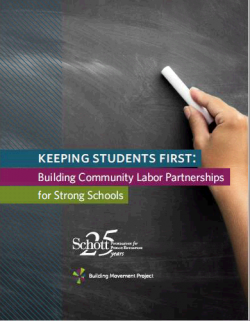Keeping Students First: Building Community Labor Partnerships for Strong Schools
This report explores what happened in two cities—St. Paul, Minnesota and Austin, Texas—where unions have established partnerships reminiscent of the alignment between labor and community groups in Chicago in 2012. Also, this report provides analysis and tools for labor and community groups nationwide that hope to overcome historical and systemic barriers in order to build trusting partnerships and shared power.
A collaborative partnership in which teachers’ unions pursue community-defined priorities for education through contract negotiation requires an expansive view of the role of labor that extends beyond traditional union activity. In more traditional relationships between labor unions and community organizations, engagement can often be limited to financial sponsorship for local events, or contractual relationships in which unions pay community groups for local organizing to support the union’s campaigns. In our research, we have found that a shift toward more collaborative community/union partnerships generally requires the affirmative support of the union. This support can come from new union leadership—as occurred in Chicago, where CORE members ran a campaign to take over the elected leadership of the union—or a proactive push by rank-and-file members in this direction—which can come slowly or haltingly. Increasingly, however, both teachers’ unions and community groups have come to realize the strength that comes from partnering with each other, and are looking towards new collaborative models for ensuring the best education and schools for students, that include fair working conditions for teachers and staff.
While we found that community organizations may have limited ability to transform or re-balance the power dynamics at work in their relationships with labor until there is momentum from inside the union, education organizing and advocacy groups can be attuned to potential areas where union and community interests overlap and focus on the potential to make meaningful connections and demonstrate the power and value of local organizing.
The insights in this report offer snapshots of the evolution of partnerships between teachers unions and community in St. Paul and Austin. The full stories of the cities, communities and relationships featured in brief here are far richer and more complicated than a case example allows. We don’t endeavor to capture every nuance of the events described; rather, we hope to offer some insight for how community and labor partnerships can be established and nurtured, with the acknowledgement that the story is complex and ever-evolving. Every partnership is unique, but some themes emerged through a series of over thirty interviews with labor and community leaders nationally, as well as in St. Paul and Austin, that have worked to build meaningful collaborations:
- Move Beyond the Transactional: Successful collaboration does not rely on transactional exchanges that are limited to the campaign at that moment. Building meaningful relationships and trust requires open communication and frequent engagement over time.
- Expand the Issue Lens: The alliances that were successful over time were not restricted to traditional school issues: they took an expansive view of what affects the community and thus, its students, engaging on policy issues including immigration, home foreclosures, police violence, local wages, and child care and early childhood resources outside of the school day. Union strategy development must be reflective and responsive to the needs of parents, students and teachers in order to truly make the partnership collaborative and
meaningful. - Engage, Even when Difficult: Establishing new collaboration and taking on challenging issues often requires difficult conversations. In many of the large cities and jurisdictions where unions hold significant power, the teachers’ union membership includes proportionally fewer teachers of color than the communities they serve. Addressing issues like school discipline and safety, which are common challenges for teachers and students both, requires engaging with difficult issues of structural racism and implicit bias. Tensions over these issues can make partnerships falter. To find common ground and sustain the partnership through difficult conversations, all parties must approach the conversations and the language used to describe the issues with care.
- Be Patient: Although building meaningful community/labor partnerships takes time, they build the power of all parties, and make it harder for officials to ignore. “It’s tough for those in power to penetrate these alliances,” one interviewee told us.
This report is designed to support community and labor groups that are ready and willing to engage in meaningful relationship building and collaboration. The case examples of union/community collaboration in St. Paul and Austin highlight two state capitals with distinctly different labor climates and educational challenges. Nonetheless, both unions succeeded by bringing the community into strategy development and partnership in a meaningful way. This report also contains two sample exercises designed to support labor and community groups beginning to work together to explore how to better support students. “Building Our Schoolhouse” encourages parents, teachers, students, and other allies to find common ground for a vision for the schools students deserve, and identify plans for working together to create these environments for students. “Network Mapping” will help teachers, parents, and others consider the influences that affect students both in their academic success and in their overall wellbeing, with the goal of identifying both allies in supporting students and challenges that need to be addressed. We hope these case examples and exercises help provide a road map of the initial steps for labor and community organizations to begin the work of increasing trust and collaboration to build their collective power to fight the corporate privatization of public education in the nation.

